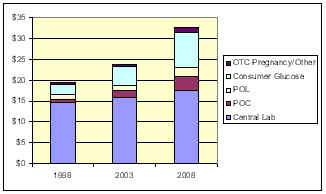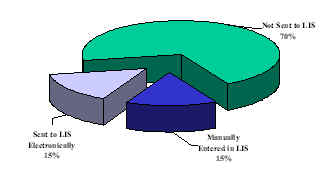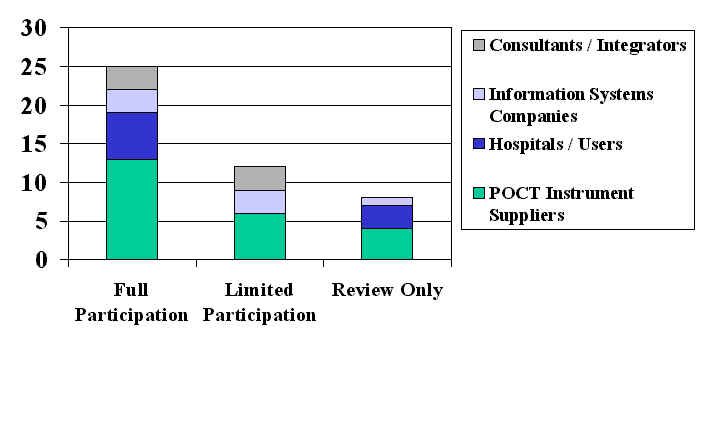AACC Industrial Liaison Committee Minutes |
|
Reprint of Executive Summary distributed by Emery Stephans, Chair, Industrial Liaison Committee.
Summary of the July 27, 1999 Industrial Liaison Open Committee Meeting |
List of Participants |
The Industrial Liaison Committee of the AACC Point-of-Care Testing Division conducted an open meeting on July 27th during the 1999 AACC Annual Meeting in New Orleans. This meeting was the second sponsored by the Industrial Liaison Committee, and was organized by Emery J. Stephans, chair of the Committee. During last years' AACC Annual Meeting in Chicago, the Committee met in an open session to identify unmet needs in POCT. The consensus of the attendees at that meeting, representing all AACC POCT constituencies, was that the lack of standards for connectivity and data management was their most significant problem. The goals of the 1999 Committee Meeting were to propose an open industry consortium for the development of POCT standards and to solicit suggestions and support for this proposal.
Invitations were sent to individuals representing hospitals, POCT instrument suppliers, LIS and HIS companies, regulatory and standards organizations, as well as to members of the POCT Division. The meeting announcement was published on the POCT Division's web site www.aacc.org/divisions/poct/default.stm, and the AACC sent out a mass mailing to its list. Every effort was made to ensure that all interested parties were aware of the meeting. More than 120 people attended the meeting, representing over 48 different companies and institutions.
Representatives from major health care centers, including Dr. Jay B. Jones of Penn State Geisinger Health System, Dr. Kent Lewandrowski of Massachusetts General Hospital, and Dr. James H. Nichols of Johns Hopkins Medical Institutions expressed their views as users of POCT devices. They detailed the necessity for standards, the problems encountered due to lack of standards, and the types of standards their organizations required. Their presentations demonstrated clearly that the potential benefits of POCT to health care organizations and the industry can be realized only if POCT can be integrated in the information systems of the user institutions. The speakers also emphasized that this integration of POC testing can't be accomplished without standards for connectivity and data management.
An executive from a leading LIS vendor, Scott Elliott of Sunquest Information System, described the adaptations developed by his company in partnership with a POCT supplier and a user. Together they developed an EDI interface for blood glucose monitors to transmit test data to the LIS for quality control and patient records. He noted that, due to the lack of standards, POCT devices might require customized support in the LIS. For LIS companies, standards would enhance their ability to provide required features and support to their customers.
After its 1998 meeting, the Industrial Liaison Committee had initiated efforts to find a means to provide standards for POCT. After extensive discussions, the approach used by Hewlett-Packard in the Andover Working Group - a highly successful member-funded consortium on standards for hospital hardware/software inter-operability - was determined to be the best solution. The Committee invited Hewlett-Packard to outline a plan for an industry consortium to develop POCT standards. Dr. Dirk Boecker, Principal Scientist and Head of the Medical Department at HP Laboratories, outlined the POCT environment, the requirements for a fully-integrated POCT data flow, and presented the proposed plan for a member-funded industry consortium. The consortium would include core members, supporting members and affiliate members, encouraging each organization to participate with an appropriate level of involvement. The consortium would be open to any party interested in POCT, and would develop open standards for the industry.
Supplier representatives spoke in support of the proposed consortium and commented on the need for open standards. They volunteered the active participation of their companies. Other attendees encouraged the inclusion of standards organizations in the consortium, as affiliate members, to take maximum advantage of current associated efforts.
The meeting concluded with a survey to determine the level of interest among the attendees in the proposed plan. Based on 91 completed surveys representing 52 different companies and institutions, more than 80% concurred with the proposed plan and volunteered the active participation of their organizations in the consortium. An additional 14% expressed interest in reviewing the work of the consortium.
Hewlett-Packard set the date for a workshop on October 20, 1999 at HP Laboratories in Palo Alto. The objective of the workshop is to launch a POCT Open Industry Consortium to overcome the connectivity barriers in POC testing. POCT users and suppliers, LIS and HIS companies, integration service providers, and representatives of standards organizations are invited to attend this meeting and participate in the work of the Open Industry Consortium. Please refer to the Hewlett-Packard consortium web site at http://poc.labs.agilent.com/poc for registration information.
I. Introduction
![]() Back to top
Back to top
As the fastest growing segment of the in vitro diagnostic industry, point-of-care testing offers a significant opportunity to providers for more timely and more cost-efficient care, and to suppliers for new markets. This opportunity, however, may be slow to materialize if standards for connectivity and data management of POCT are not available. The AACC POCT Division, chaired by Dr. Petrie Rainey of Yale-New Haven Hospital, decided to serve as a catalyst to the industry to find a solution. As Chair of the Industrial Liaison Committee, Emery J. Stephans, President of Enterprise Analysis Corporation (EAC), organized an open committee meeting during the AACC 1999 National Meeting to propose a plan for developing standards for POCT.
Mr. Stephans introduced the proposed plan as an Open Industry Consortium based on the model of the Andover Working Group led by Hewlett-Packard. The Andover Working Group developed standards for hospital hardware/software interoperability. A similar member-funded consortium, under HP leadership, is proposed to develop standards for connectivity and data management of POC devices.

Mr. Stephans illustrated with charts, based on industry projections and EAC's own research, a projected annual growth rate of about 13% in the POC market.
He estimated that this growth rate would be reduced by half if standards for connectivity and data management are not available. The benefits of standards would accrue to suppliers, for whom the costs of developing proprietary solutions are prohibitive, and to users who must cope with the ever-increasing multitude of interfaces. Since no company can be expected to dominate with its own standards, a voluntary, cooperative, open consortium seems the best solution.
II.
Participation
![]() Back to top
Back to top
A primary concern of the POCT Industrial Liaison Committee in organizing this meeting was to ensure that all interested and affected parties would have an opportunity to express their views. Therefore more than 150 invitations were sent to POCT instrument suppliers, hospitals, LIS and HIS companies, and standards organizations, as well as to the 750+ members of the POCT Division of AACC. The AACC also sent out a mass mailing to over 700 people. A meeting announcement was posted on the POCT Division web site www.aacc.org/divisions/poct/default.stm. More than 120 people attended the meeting. Based on 91 surveys returned to date, the breakdown of representation is as follows:
Organization Type |
Organizations |
Attendees |
| POCT Instrument Suppliers | 28 |
64 |
| Hospitals / Users | 9 |
9 |
| Information Systems Companies | 7 |
9 |
| Consultants / Integrators | 6 |
7 |
| Others | 2 |
2 |
Total |
52 |
91 |
III.
Comments and Presentations
![]() Back to top
Back to top
John Mangini of Enterprise Analysis Corporation presented preliminary results of an EAC survey of POCT connectivity at 250 hospitals. His data showed that only 15% of POC test data are transmitted electronically to the LIS; another 15% are entered manually; 70% are not transferred at all to the LIS.

Leading representatives of the POCT users in health care centers and an executive from one of the major LIS companies were invited to present their concerns, requirements and/or suggestions regarding standards for data collection and data management for POCT. Several users commented on the current state of POC testing. Their presentations demonstrated clearly that the potential benefits of POCT to health care organizations and the industry can be realized only if POCT can be integrated in the information systems of the user institutions. The speakers also emphasized that this integration of POC testing can't be accomplished without standards for connectivity and data management.
Jay B. Jones, PhD, Penn State Geisinger Health System described the challenges involved in covering nearly a third of the state of Pennsylvania with distributed, decentralized services. James H. Nichols, PhD, Johns Hopkins Medical Institutions asserted that POC testing involves the capture, transmission and management of data. These operations must be standardized such that POCT and laboratory data can be integrated with electronic patient records. This utilization and management of data will drive increased POC testing. Kent Lewandrowski, M.D. - Massachusetts General Hospital commented on the cost and complexity of integrating test results from three different POC instruments in the Emergency Room, when all three were needed to cover the desired menu and none provided output compatible with any of the other.
Scott Elliott, Sunquest Information System, described the adaptations developed by his company in partnership with a POCT supplier and a user. Together they developed an EDI interface for blood glucose monitors to transmit test data to the LIS for quality control and patient records. He noted that, due to the lack of standards, POCT devices might require customized support in the LIS. Concerns he cited were with ensuring a positive patient ID and with the difficulties of integrating results from manual POC devices for QC and patient records. For LIS companies, standards would enhance their ability to provide required features and support to their customers.
IV.
Hewlett-Packard Proposed Plan
![]() Back to top
Back to top
Dr. Dirk Boecker, Principal Scientist and Head of the Medical Department at HP Laboratories, outlined the POCT environment, the requirements for a fully-integrated POCT data flow, and presented the proposed plan for a member-funded industry consortium. The consortium would include core members, supporting members and affiliate members, encouraging each organization to participate with an appropriate level of involvement. The consortium would be open to any party interested in POCT, and would develop open standards for the industry.
Jack Harrington of Hewlett Packard described the structure and activities of the Andover Working Group (AWG). The AWG consisted of Core Members, who dedicated full-time technical resources, attended monthly meetings, defined specifications, and implemented software; Supporting Members, who submitted ideas and received early specifications; and Affiliate Members, who provided the liaison between the AWG and other organizations, e.g. HL7, Microsoft Users Group, ASTM. Mr. Harrington believes that a similar model can be effective in developing standards for POCT.
Hewlett-Packard prepared a "POC Whitebook", Point-of-Care Integration Analysis, to describe the POC environment and the requirements for connectivity and data management. This document was distributed at the Industrial Liaison Committee Meeting and is available at the Hewlett-Packard web site at http://poc.labs.agilent.com/poc. Comments and suggestions are encouraged by the authors, Jeff Perry and Dirk Boecker.
Given the strong interest in the consortium, Hewlett-Packard set the date for a workshop on October 20, 1999 at HP Laboratories in Palo Alto. The objective of the workshop is to launch a POCT Open Industry Consortium to overcome the connectivity barriers in POC testing. POCT users and suppliers, LIS and HIS companies, integration service providers, and representatives of standards organizations are invited to attend this meeting and participate in the work of the Open Industry Consortium. Please refer to the consortium web site at http://poc.labs.agilent.com/poc for registration information. Dr. Boecker's presentation is also posted on this web site.
V. Survey
Results
![]() Back to top
Back to top
Based on 91 completed surveys representing 52 different companies and institutions, more than 80% concurred with the proposed plan and volunteered the active participation of their organizations in the consortium. An additional 14% expressed interest in reviewing the work of
the consortium. The survey results are depicted below, followed by a list of the companies and institutions that wish to participate in the consortium. A list of all individuals who attended the Industrial Liaison Committee Meeting and responded to the survey will be posted on the Hewlett-Packard consortium web site at http://poc.labs.agilent.com/poc. List of Open Industry Consortium participants.
Organization Type |
Full Participation |
Limited Participation |
Review Only |
| POCT Instrument Suppliers | 13 |
6 |
4 |
| Hospitals / Users | 6 |
- |
3 |
| Information Systems Companies | 3 |
3 |
1 |
| Consultants / Integrators | 3 |
3 |
- |
Total |
25 |
12 |
8 |

If you would like to join the Open Industry Consortium, indicate you desired level of participation to Emery Stephans, Chair, Industrial Liaison Committee, AACC POCT Division
![]() Back to top
Back to top
[ Home | Search | Index | Feedback ]
Last updated: 09/16/2009
Questions or corrections: My Point of Care.net
© 2000 Medical Automation Systems, Inc. Legal Notice.